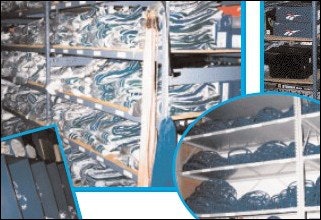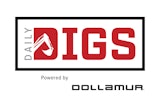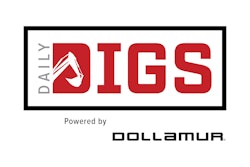The basics of equipment inventory haven't changed, but the technology has.

It is not as if pencil and paper will disappear tomorrow. Face it, when your telephone rings and you have to quickly jot down a number, a pencil and paper can handle the job quicker than the average laptop.
The information flow in the typical equipment room is a lot more complicated than 10 digits, however. Each year, thousands of compression shorts, socks, sweatshirts, cups, helmets, pads, shin guards, shoes, sticks, gloves, bats, racquets, balls and pucks will move in a constant whir in and out of the equipment room, from your available inventory to each athlete's personal inventory and (you hope) back again.
Knowing not just the number, but the type, size, color, condition - and current location - of all these wayward pieces of equipment is what separates those who issue equipment and those who manage it. Pencil and paper will work. Computer software and bar-coding systems will merely make your work quicker and more efficient.
Yet, the foot-dragging persists, much to the chagrin of the companies currently developing, perfecting and applying bar-coding technology to meet the needs of equipment managers. "A lot of people say it's too high-tech for them," says John Szczypinski of Chapel Hill, N.C.-based Privatech. "I tell them they'll come around soon enough."
Les Totten of Woodinville, Wash.-based SportSoft says his product's newness is enough to scare away a large number of prospects. ("It might as well be New Coke," he says.) But the primary obstacle, he says, is the apprehension with which many people still approach computers - even if they already accept computers' role in other aspects of their lives.
"We're offering people a new way of doing business," Totten says. "It's like 15 years ago, when secretaries had typewriters in front of them and people would come in and try to sell business owners on word processors. Equipment managers sometimes ask, 'Why shouldn't I just use pencil and paper?' I ask them, 'Does the athletic director's secretary have a word processor, or does he or she use pencil and paper?' "
To be sure, purchasing a complete package - one (or several) computers, a software package and bar-code scanners - will be beyond the financial wherewithal of many high schools and smaller colleges. Other schools may already have computer systems in place that are not compatible with most equipment-management software. Finally, proper implementation of such a system is time-consuming, requiring a complete and accurate inventory, the development of bar codes and a corresponding identification system, and a great deal of initial data entry. Once everything's in place, though, the benefits can be enormous, say software developers and the systems' users.
Jeff Marr, equipment coordinator at Oregon State University, joined the department as a student assistant in 1987. Over the years, the department graduated from paper and pencil to Lotus spreadsheet software, then to Microsoft-compatible database programs such as Excel and Access. Marr sees this as a natural progression - from spreadsheets that can help organize information to databases that can perform calculations and combine different sets of information in answer to specific queries. Bar-coding, the logical next step, replaces entering complete information about a specific piece of equipment with a simple swipe of a scanner over a bar-code label. Marr is working closely with his software provider to add features that will allow a wide variety of information to be entered and utilized.
"I've always worked with computers and don't have any fear of them," Marr shrugs. "In fact, I enjoy working with them, so I pretty much tailor programs to meet my needs, and bar-coding fits right into this environment. I really perceive the future of the equipment room being much like a supermarket. An individual will come to the counter and be issued whatever he or she needs, and the bar code will allow that information to go right into the computer. We'll track who is issued what at what time and what day, the size, quantity, condition of the equipment and other information.
"It's really fast; supermarkets can attest to that. It's accurate; it'll track whatever you ask it to track. It's the direction I want my equipment room to go in. I want to be able to tie all sports together in a network so I can sit at my desk and see how many socks I have left, how many I used last year, how many I need to reorder. I want all that information right there in front of me."
The software packages accompanying different bar-coding systems vary in their equipment-management capabilities, but operate according to similar principles. Implementation of any system has one prerequisite: an organized equipment room.
The equipment manager's first step is to separate all equipment - by sport, type, size and color - and to create a different bar-code identification for each. Rarely are all items affixed with labels. ("Eventually they're going to start falling off," warns Szczypinski.) Instead, labels are produced and placed in a binder (or "bar board," in bar-code parlance) that sits at the issuing desk. Some systems print customized labels that include a description of each piece of equipment; some shoe and helmet manufacturers are even beginning to affix bar-code labels on their products. (The difference between his system's labels and those placed on helmets by Schutt Sports? "Theirs stick," Marr says. "Mine don't.")
Dennis Fisher, head equipment manager at Brigham Young University, has been working feverishly to have his new bar-coding system up and running by the time fall sports teams return to school this month. Each of his labels' limited number of digits corresponds to another piece of information that his system can track. For instance, X51.01-08 - "X" is men's track, "51" is shoes, "01" is a Reebok Interval, "08" is the size. If Fisher needs a report on a particular type of equipment, he can scan the appropriate label on the bar board. If he wants the status of all his Reebok men's track shoes, for example, typing in "X51, 01 to 90" will do the trick.
Systems developers are still learning how to customize software more typically used in supermarkets to the specific needs of equipment managers. For instance, most systems will create pages with different option fields for expendable items (socks, for example) and nonexpendable items (football helmets). Others make a distinction between those and serialized items such as padlocks. Lockers in the five locker rooms under Fisher's jurisdiction come equipped with built-in locks whose preset combinations are on a five-year rotation; Fisher's software includes a locker database that shows all five combinations and the current one being used for each locker scanned into the system.
And, of course, the equipment is only one-half of the equation. For the system to operate, student-athletes also have to be "labeled" and "scanned." Fisher says he's fortunate in that BYU's students all carry IDs that already have bar-code labels on them. In his case, it is a simple matter to scan the student-athlete's ID and then the bar-code label for each piece of equipment issued. Afterward, the system keeps a database for each student-athlete in addition to the database for all on-hand equipment. Totten says that in a very real sense, the technology works in the reverse of people's expectations. "They're not issuing a helmet to a student, they're issuing a student to a helmet," he explains. "The helmet always stays in the inventory, but the students are always changing."
Once the system is in place, linkage with other department databases becomes a real possibility, but such applications appear to be a little premature. Fisher's system, like most, is very self-contained, even though the business manager will have access to it. Fisher is excited about the potential for streamlining the purchasing process. "I will be able to run a report that shows an item number, a description and even a model number," he says. "When I order equipment, it will be really easy for me to just attach this report to a purchase order and send it up to the purchasing agent."
Using part numbers or other purchasing-related identifiers on bar-code labels would appear to be a good first step toward accommodating future expansion. Marr says Oregon State's network administrator is looking into tying Marr's system into the athletic department's system and beyond. Marr gets wistful contemplating such a linkage, which would tie equipment issue to billing and purchasing.
"I would certainly like to do all our purchases over the network," he says. "Right now I have to transfer everything onto a piece of paper and walk it up to the business office. That's a regular routine. We're about to move into a new facility that will be separate from our business office, and when it's raining out here all winter long I won't like walking up there. If I could plug in the information on my end and have the purchase order show up in the business office from my desk, that would be awesome.
"That'll be the next step," he predicts. "The electronic age is here, that ability is now. We've just got to get it incorporated into the equipment room."
Once you have all that information in front of you, what can it do for you. Barcoding proponents cite four areas where equipment managers can benefit:
1. Time savings. Time is saved at the receiving dock, as new items are scanned into an existing database, immediately updating all information on the system. At the issue window, two swipes of the bar-code scanner are enough to move inventory from the on-hand database to the student's personal database. In the office, one terminal holds all information pertinent to the equipment manager's job; if a certain type of item must be tracked, a few keystrokes will provide the answers where previously all students' files would have to be accessed by hand. And at inventory time, a piece-by-piece count of every item may no longer be necessary; certain items can be spot-checked to ensure the system's accuracy.
Marr says that before bar-coding, he had to spend much more time watching what left his equipment room and double-checking his inventory to get an accurate count of remaining goods. "In the past, we didn't always get what was issued down on paper. That was a problem," he says. "Now, my student managers and student assistants can do the issuing without me having to know what they're issuing. I can always go back and reference it. Once you get your students and equipment room workers accustomed to scanning items, there's an automatic record of every transaction."
What if users neglect to scan an item? Szczypinski says, "I guess the scanner is kind of fun to use, because they don't forget to do that."
Any other way the system can break down?
"Dang it, computers crash," Marr says. "My hard drive did crash one time. I'd had the thing just long enough to enter a ton of information, very little of which was backed up. That was the last time I got burned that way."
2. Reduction in lost equipment. A marketing research survey performed recently by SportSoft found that this was the primary benefit of bar-coding cited by equipment managers. This came as no surprise to Totten, who before founding SportSoft had worked for a bar-coding company and coached high school football. Explaining his company's genesis, Totten says, "I got tired of trying to figure out whose helmets and shoulder pads were lying around the dressing room floor after practice. What we used to do was round up all the misplaced equipment, lock it in the coach's office and wait until somebody marched on the field without a helmet on. Then we'd go unlock the office and dish out some punishment. I thought, 'There has to be a better way.' "
Privatech got into equipment management in a similar way, after a friend of Szczypinski's, an assistant equipment manager at North Carolina, came to him with a complaint.
"He said, 'I'm sick and tired of going to the shelf and what I'm looking for isn't there,' " says Szczypinski. "When the end of the year came, they couldn't account for all their inventory."
Bar-coding systems, Totten notes, won't prevent the loss of equipment, "but at least it'll let you know where you're losing it. When you've got a kid supplying the whole dorm with socks, now you'll know who he is."
Fisher can back this up. Many of the expendable items he stocks come gratis from sponsoring corporations, but the supply is limited, meaning Fisher can't afford to replace shirts or shorts athletes claim have been lost or stolen every other week. To combat the problem, Fisher is instituting reports of lost or stolen merchandise that athletes will have to get a coach's signature on before they can get items reissued. In addition, the bar-code system will generate a receipt for each piece of merchandise issued, on which dollar amounts for all items will appear.
"In the past, we had a lot of stuff just passing out the window, and we didn't hold the athletes accountable. And ultimately, we're accountable," Fisher says. "The automated account we have will show just how many pairs of shorts each individual player has been issued, and it'll get to the point where I'll draw the line. If athletes want another pair of shorts they'll have to buy them."
3. Money savings. Saving time and limiting the amount of equipment issued will both save money, but there are other money-saving areas, too. Bar-coding systems' greater accuracy means less overage is purchased. Also, Totten says, in the case of helmets, information on their reconditioning status can be scanned into the system. Knowing the reconditioning schedule of each helmet will prevent helmets that have not been issued in a given season from being sent unnecessarily to a reconditioner.
Fisher believes such savings should easily pay for his department's initial investment. Since they already had one computer in each of two offices, one at each of two issue windows and one at the receiving window, their costs were limited to software and three scanning devices. "It's not that expensive," he says. "Adding the bar-coding made it more expensive, but the software cost around $500 and we haven't been charged for many of the customizations we implemented."
4. Liability. Like the reconditioning schedule, other information can be entered as non-expendable items break and are repaired. Software developers are just beginning to add this feature, as equipment managers and athletic directors share their liability concerns.
Marr says this is one area for which he still uses paper and pencil, but he's hoping to incorporate it into his system soon. "With items like helmets and shoulder pads, I want to track each item individually and know its history," he says. "If an equipment manager is named in a lawsuit and during testimony can document how that specific helmet has been maintained and repaired, it really goes a long way toward showing your efforts at preventing injuries."
SportSoft is going one step further in this area - its software will alert equipment managers when a particular helmet needs reconditioning. "The program is going to make sure the coach or equipment manager is conscientious, because there'll be a record of their being notified," Totten says. "They choose to ignore that at their peril."
Do improvements to technology improve the field of equipment management? Marr thinks so.
"Technology is changing the common perception of what an equipment manager is - an old codger sitting down behind a cage issuing socks and jocks," he says. "There are some individuals out there like that, who don't see what computers can do for them, but with more computer-savvy people coming into the field, it's definitely changing. It's evolving into a professional profession."



































